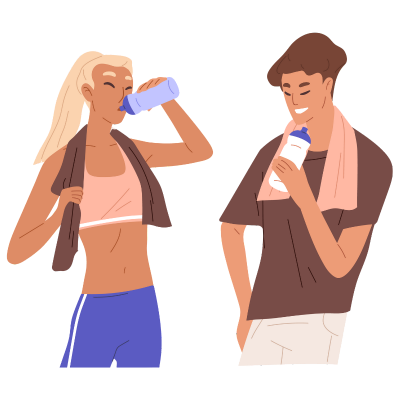What are your plans for the summer!? Naturally, we are more active outside in the Spring and Summer months. Maybe you are planning to run a marathon or participate in another type of outdoor event this summer, maybe you have a child or adolescent participating in outdoor sports or competitions, or maybe you just plan to be out on the golf course as much as possible! Whatever sport and exercise look like for you in the hot months of the year, it is important to consider some of the risks that can come with exercising in the heat and some strategies to help protect against this (see Crystal’s article for more on heat illness)! While exercising in the heat, blood flow to the skin and sweat rate increase to allow for heat evaporation to the surrounding environment. These thermoregulatory adjustments increase physiological strain and may lead to dehydration, impaired performance and potentially heat illness during prolonged exercise. Here are some considerations when exercising in the heat to reduce your risk of these occurrences!
 Hydration
Hydration
- Before training and competition in the heat, it is recommended to drink 6 mL of fluid per kg of body mass every 2–3 h in order to start exercise euhydrated (optimal total body water content).
- To truly determine the hydration replacement amount for an individual, it is best to get an idea of how much fluid is lost through sweat while in the heat. To do this, we can calculate the sweat rate. This is especially important for athletes or those who are regularly participating in exercise in the heat. The simplest way to assess fluid loss during exercise would be to weigh the athletes before and directly after activity, and then modify rehydration based on findings. If weight loss, hydrate more. If weight gain, hydrate less. To be more specific, the formula for calculating sweat rate is: pre-exercise body weight – post-exercise body weight + fluid intake – urine volume/exercise time in hours. This will help individuals personalize their hydration habits during training and competition.
- The main electrolyte lost in sweat is sodium. During prolonged exercise in the heat, supplementation of sodium is often recommended (especially for “salty” sweaters) to maintain plasma sodium balance which is very important for blood pressure control as well as nerve and muscle activation and brain function. Consider adding an electrolyte supplement with adequate sodium to your water to prevent this imbalance. Electrolyte tablets such as Nuun Sport or LMNT are great options!
- Recovery hydration regimens post-exercise should include sodium, carbohydrates, and protein!
Cooling Methods
- If you are out in the heat for prolonged periods regardless of whether you are exercising or not, cooling methods to reduce body temperature and excessive sweating should be considered.
- Cooling methods include external (e.g., application of iced/cold garments, towels, water immersion, or fanning) and internal methods (e.g., ingestion of cold fluids or ice slurry).
- Precooling (using the above methods prior to exercising) may benefit sporting activities involving sustained exercise (e.g., middle- and long-distance running, cycling, tennis, and team sports) in warm-hot environments. Internal methods can be used during exercise whereas tennis, golf and team sports can also implement mixed-cooling methods during breaks
- However, precooling may not be viable for explosive or shorter duration events (e.g. sprinting, jumping, throwing) conducted in similar conditions as it could actually impair performance.
In general, cooling methods should be tested and individualized during training prior to use in competition to minimize disruption to the athlete and their performance.
Heat Acclimatization
- Another important consideration for those planning to exercise in the heat, especially athletes, is heat acclimatization. Heat acclimatization is the improved tolerance of heat that can come from repeated training in hot conditions.
Although early adaptations are obtained within the first few days, the main physiological adaptations to training in the heat occur at about 1 week. Ideally, the heat acclimatization period should last 2 weeks in order to maximize all benefits.
- Heat acclimatization sessions should last at least 60 min/day and should cause an increase in body core and skin temperatures, as well as stimulate sweating. This is also a great time to calculate sweat rate in these conditions to plan for proper hydration during competition.
- Competitors should train in the same environment as the competition venue if possible. There are other factors such as humidity, elevation, and differing terrain which can also significantly affect performance if not properly acclimatized to.
Krystyna Woodson, (MKin, BSc. Kin, CSEP-CEP, CPT)
Clinical Exercise Physiologist & Personal Trainer
